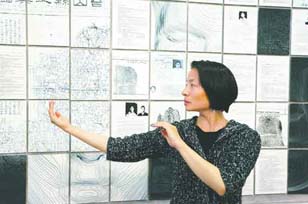
Tales of the American dream
USINFO | 2013-08-12 15:28

Choreographer Lenora Lee examines her immigrant grandparents' past through her research and artistic creations.
"A discrimination law used to force my grandparents apart, husband in San Francisco, wife in China. It took them 10 years of waiting and struggle to be together," the 39-year-old dancer and choreographer tells China Daily at the de Young Museum in San Francisco.
Creating works that are both personal and historical to her own family, Lee is in the process of developing two performances, The Escape and Rescued Memories. Both are inspired by stories of Chinese women who emigrated to the United States in the late 1800s and early 1900s.
As a de Young Artist Fellow, Lee brought The Escape to the museum in May as a free performance open to the public. "My initial hope was to be able to share these stories (through various artistic disciplines) in a creative and compassionate way that would provide insight into the experiences, hardships, challenges, triumphs, and transformations of the people in these Chinese-American communities over the years," she says. Lee conducted her research in 1996 as an exchange student from UCLA at Peking University.
What inherently came along with the process and research was an education for herself, the cast, and ultimately the audience on the subject of human trafficking and the hardships imposed by the Chinese Exclusion Act of 1882, she says.
As part of an early generation of Chinese immigrants, Lee's grandparents seldom spoke about their history with Lee, one reason being that they had to come to the US under false names. They were called simply "Paper Son" or "Paper Daughter".
In the early 1920s, her grandfather left Taishan, a farming village in Guangdong province, and landed at San Francisco's Angel Island, which was being used at the time as a US Bureau of Immigration inspection and detention facility.
Life was hard for early generations of Chinese immigrants, who could not find work outside of Chinatown. Lee's grandfather could not afford to buy the fake identification papers, which cost as much as $3,000, to bring his wife over from China. Desperate and in despair, he wrote a letter back to her in China and asked her to marry someone else if she didn't want to wait.
"I will wait for you until I die!" his wife replied and her letter gave him new hope. Ten years later, reunited at last, the couple was able to settle down and start a family in San Francisco.
Lee's research also received support from the Donaldina Cameron House, a Chinatown-based organization named for the missionary who provided a haven for thousands of young Chinese women throughout the Exclusion Era, women who had come to the United States imagining they'd find a better life, but instead were forced by traffickers into lives of domestic servitude or prostitution, Lee explains.
Lee says Cameron House has extensive archives that have become "my sources of artistic creation". Lee herself remembers attending their Friday night youth programs and educational services as a child.
She has spent hours in the archives, reading court documents and handwritten letters between female immigrants and the missionaries who helped them by providing shelter and gaining legal custody of women trapped in bad situations.
"My hope is to allow the stories to be a catalyst for dialogue and for sparking interest in understanding the deeper issues," Lee says.
Her work also serves as an avenue to share and rejoice in the courage, strength and resilience of the Chinese and Chinese-Americans who over the years built the vibrant Chinese-American communities into what they are today and highlight their tremendous contributions to American society, she says.
For the upcoming Rescued Memories: New York Stories project that will premiere at the de Young Museum along with The Escape on Nov 8 and 9, Lee would like to work with Asian or Asian American dancers both in the Bay Area and in New York City to develop an intergenerational chorus of dancers representing the Chinese-American community of that time period.
Lee says they will premiere both pieces in New York City in the spring of 2014.
Share this page



















